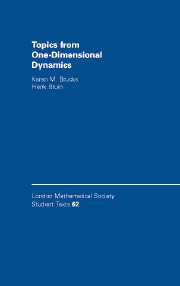Book contents
- Frontmatter
- Contents
- List of Figures
- Preface
- 1 Topological Roots
- 2 Measure Theoretic Roots
- 3 Beginning Symbolic and Topological Dynamics
- 4 Beginning Measurable Dynamics
- 5 A First Example: The 2∞ Map
- 6 Kneading Maps
- 7 Some Number Theory
- 8 Circle Maps
- 9 Topological Entropy
- 10 Symmetric Tent Maps
- 11 Unimodal Maps and Rigid Rotations
- 12 β-Transformations, Unimodal Maps, and Circle Maps
- 13 Homeomorphic Restrictions in the Unimodal Setting
- 14 Complex Quadratic Dynamics
- Bibliography
- Index
4 - Beginning Measurable Dynamics
Published online by Cambridge University Press: 05 August 2012
- Frontmatter
- Contents
- List of Figures
- Preface
- 1 Topological Roots
- 2 Measure Theoretic Roots
- 3 Beginning Symbolic and Topological Dynamics
- 4 Beginning Measurable Dynamics
- 5 A First Example: The 2∞ Map
- 6 Kneading Maps
- 7 Some Number Theory
- 8 Circle Maps
- 9 Topological Entropy
- 10 Symmetric Tent Maps
- 11 Unimodal Maps and Rigid Rotations
- 12 β-Transformations, Unimodal Maps, and Circle Maps
- 13 Homeomorphic Restrictions in the Unimodal Setting
- 14 Complex Quadratic Dynamics
- Bibliography
- Index
Summary
We frequently consider the long-term behavior of a dynamical system on a large set of orbits without knowing the behavior of every orbit. In particular, Poincaré proved a type of recurrence for all orbits except for those lying in a set of measure 0 for dynamical systems. This result is presented below and contrasts with the recurrence definitions and results of Section 3.5. This is referred to as the qualitative theory of dynamics since frequently, even though one can predict what the orbits will do on a set of full measure, it is not known precisely what will happen at even a single point! We introduce the ideas behind measurable dynamics and ergodic transformations in this chapter but refer to texts on ergodic theory such as [80, 137, 168].
The reader should be familiar with the material in Chapter 2 before beginning this chapter. The notion of a measurable isomorphism, introduced in Section 4.2, is used in Chapter 12; otherwise, this chapter is not used elsewhere in the text.
Preliminaries
We restrict our setting to the examples of interest in this book. As before, f: I → I denotes a map of a compact interval, that is, I = [a, b]. We assume in addition that I is endowed with the Lebesgue measure structure restricted to I, so we denote the measurable sets as and normalized Lebesgue measure as mI; that is, if I = [a,b], then m(I) = b a and mI(A) = m(A)/(b a) for all.
- Type
- Chapter
- Information
- Topics from One-Dimensional Dynamics , pp. 52 - 65Publisher: Cambridge University PressPrint publication year: 2004

